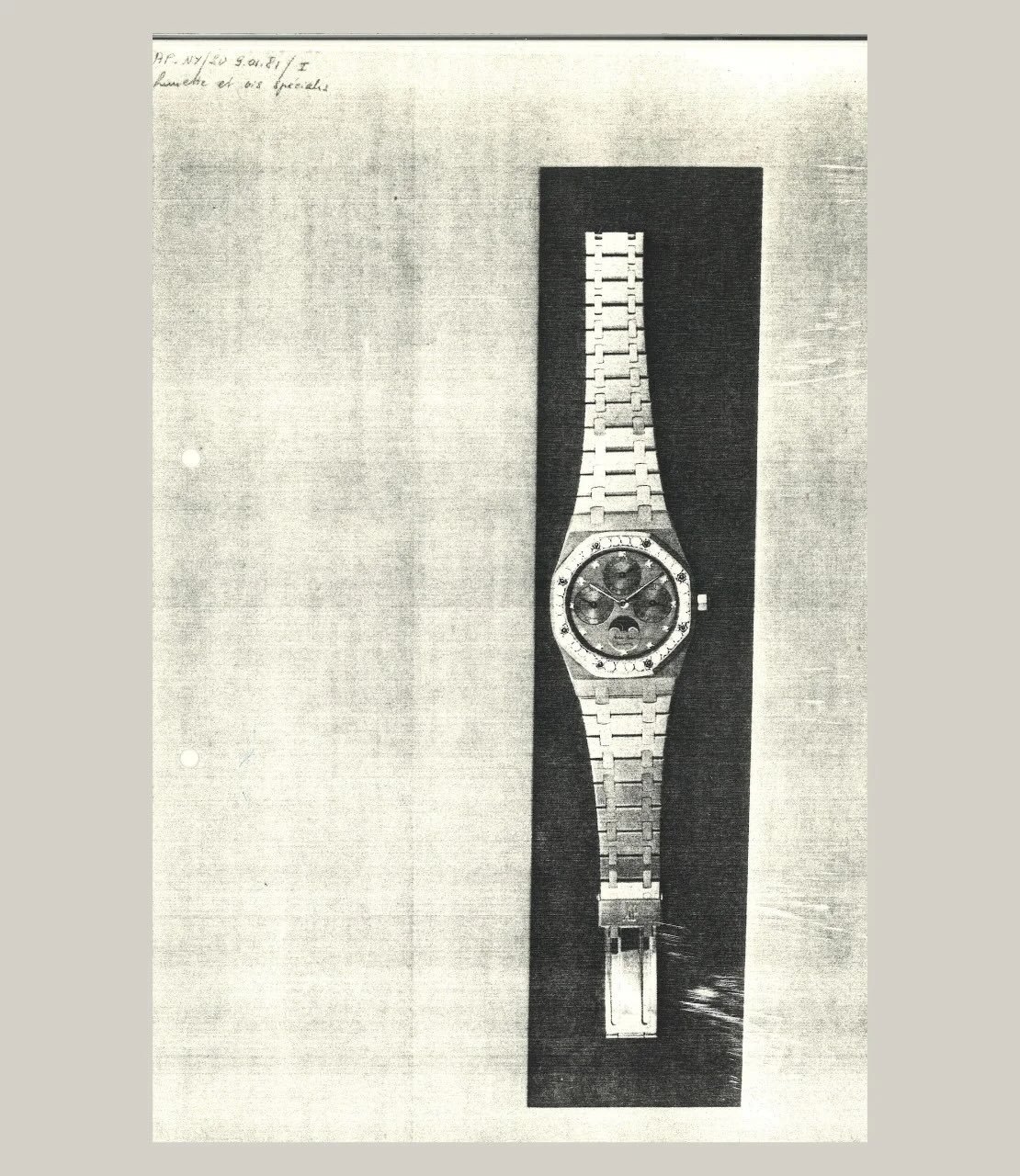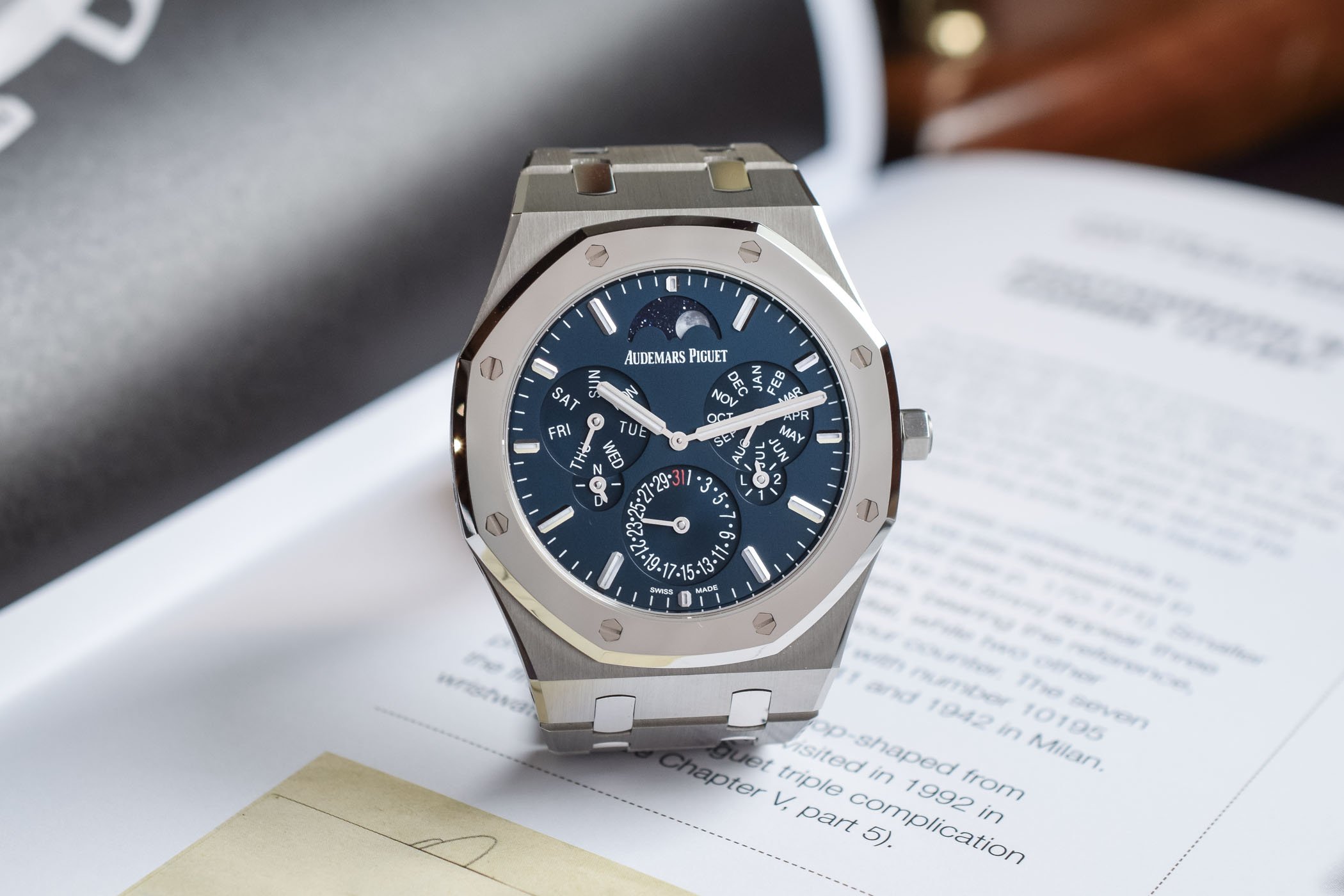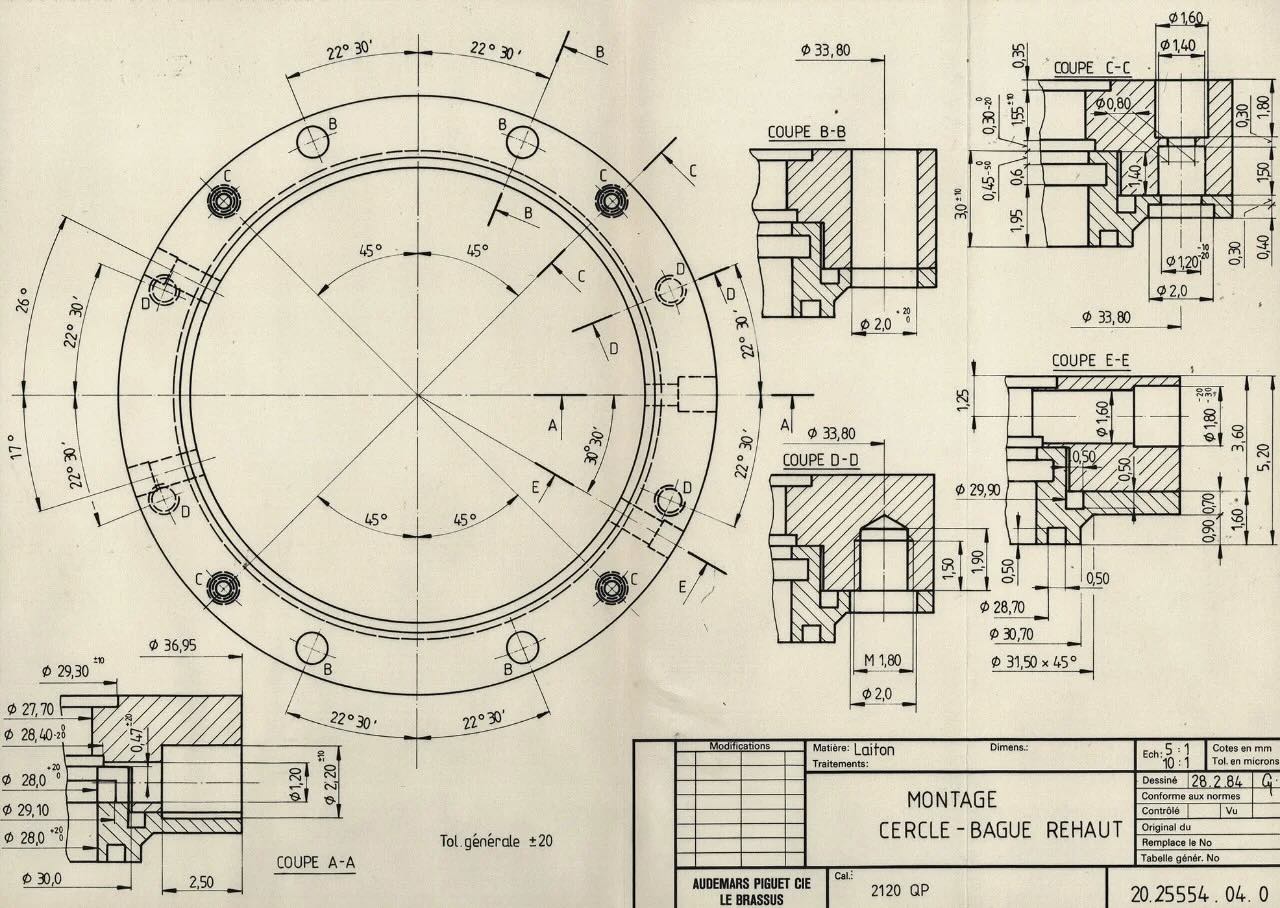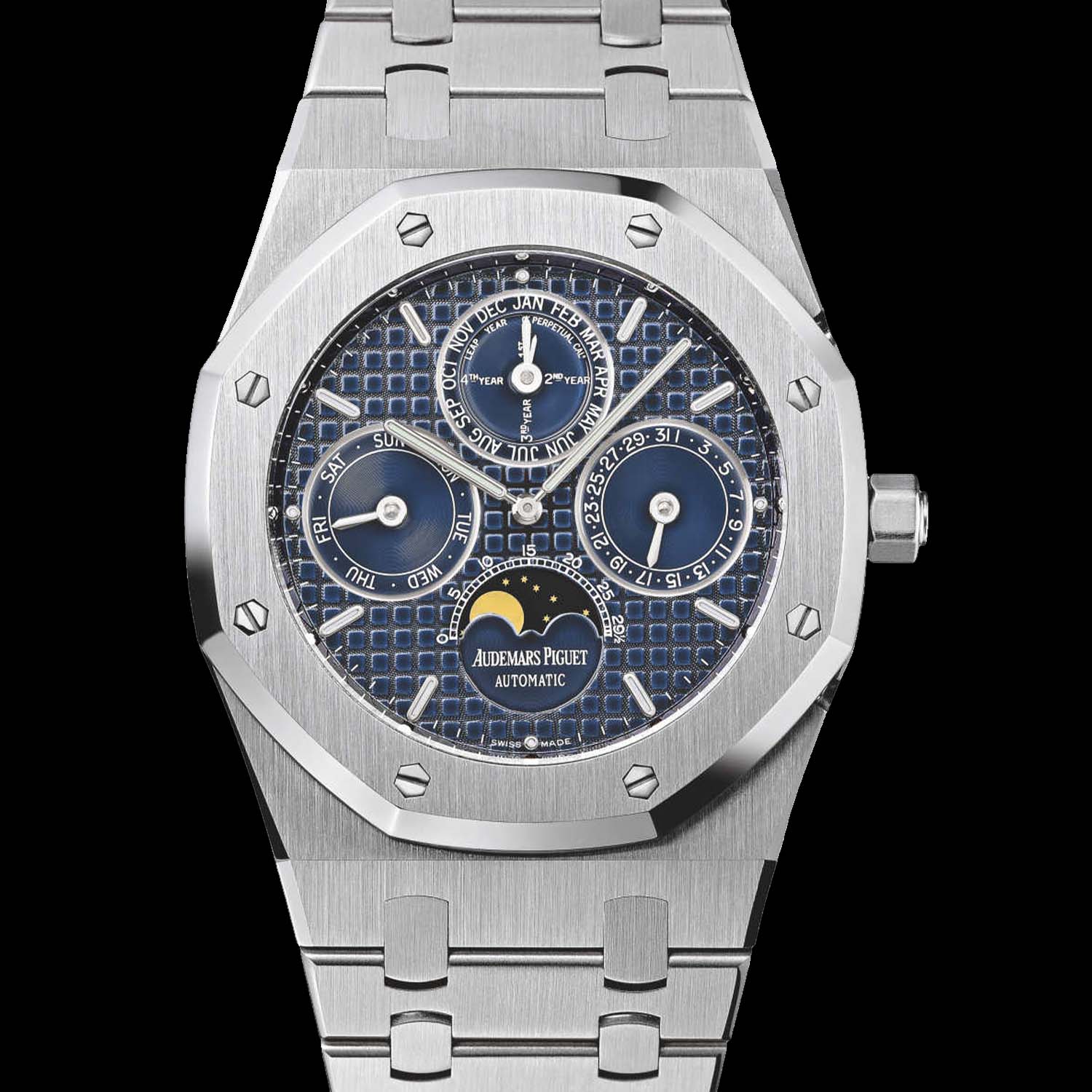The Complete History of the Audemars Piguet Royal Oak Perpetual Calendar
Rewriting the rules, respecting tradition. From early experimentation to groundbreaking innovation, the Royal Oak Perpetual Calendar has marked time.

In watchmaking, few complications command such reverence as the perpetual calendar, and few brands have woven it into their identity as thoroughly as Audemars Piguet. While the brand’s mastery of this calendar complication dates back to the early 20th century, its true renaissance came through a most unexpected path: the Royal Oak sports watch. Let us journey through its evolution, reference by reference, decade by decade, to witness how Audemars Piguet transformed technical knowledge into wearable artistry.
The First Complications in the Royal Oak Line
The perpetual calendar, which is so much a part of how we perceive the brand and the iconic sports watch now, has been a cherished complication for Audemars Piguet since the company was established. Yet, of the 208 calendar wristwatches delivered between 1924 (with the rectangular watch number 27819, the first AP calendar wristwatch) and 1969, only 12 featured a perpetual calendar, all produced in 1955 and 1957 for the legendary Model 5516, the first-ever wristwatch to indicate the leap-year cycle.

When Audemars Piguet Royal Oak burst onto the scene in 1972 with the reference 5402ST, it stunned the industry with its bold design and luxurious take on the steel sports watch. It also kept things mechanically simple, featuring only a date display. But the tides shifted a decade later as the Royal Oak collection began embracing complications, starting with calendar displays.

The first step was modest. In 1983, Audemars Piguet introduced the Royal Oak Day-Date, reference 5572. Nicknamed “The Owl” due to its large dual subdials for the day and date indications, this 36mm watch was powered by the calibre 2124/2810, a self-winding movement with a Jaeger-LeCoultre base. Though it lacked the sophistication of a perpetual calendar, its popularity signalled a strong market appetite; over 600 units were delivered before it appeared in the brand’s official catalogue in 1984.

A moon phase version of the Royal Oak joined the collection the following year, resulting in the reference 25594, the Royal Oak Day-Date Moon Phase. Produced for over 20 years, it became one of the longest-running models in the Royal Oak family. But Audemars Piguet was already setting its sights higher.
Moving to the Perpetual Calendar
In the mid-1970s, as the Swiss watch industry reeled from the quartz crisis, three Audemars Piguet watchmakers, Michel Rochat, Wilfred Berney, and Jean-Daniel Golay, collaborated to develop a modern, ultra-thin perpetual calendar movement suitable for wristwatches. Their goal was ambitious: bring one of watchmaking’s most storied complications into the contemporary era. Their proposal won over then-General Manager Georges Golay, who greenlit the production of 159 pieces, an extraordinary show of confidence for a high complication.
Unveiled in 1978, the resulting Model 5548 featured the calibre 2120/2800, the thinnest self-winding perpetual calendar movement ever made at the time, at 3.95mm thick. It combined the 2.45 mm-thick calibre 2120 base with a 1.5mm perpetual calendar module by Dubois Dépraz, mounted under the dial. The model was a commercial and critical success, and in the years that followed, the movement, tracking 4-year (1,461-day) cycles and which didn’t feature leap year indicator but was programmed mechanically to account for the leap-year, would appear in more than 110 different references, with total production nearing 7,300 units, including 791 openworked examples.

However, integrating this calibre into the Royal Oak case proved challenging. Calibre 2120/2800 demanded a 39 mm case, and production of the original 39mm Royal Oak Jumbo models was already in decline. It wasn’t until 1981 that the idea of a Royal Oak Perpetual Calendar was revived, prompted by interest from the U.S. market. An internal sketch from that year shows a Royal Oak Perpetual Calendar prototype with a gem-set bezel, drawn over a photo of Ref. 5402 and initialled by Sales Director Steven Urquhart.

Audemars Piguet’s technical office took on the project in 1983. The challenges were considerable: the 2120/2800 movement was 0.9mm thicker than the 2121 calibre used in the original Royal Oak. Case modifications had to be both subtle and functionally robust.
Engineering the Royal Oak Perpetual Calendar
The bezel was raised by 0.6mm to fit the thicker movement, and the sapphire crystal was dramatically thinned from 2mm to 0.9mm, which required abandoning the original heel-type attachment system in favour of a domed bezel at a 45-degree angle.
The Royal Oak’s hexagonal screws, a signature design element, also complicated matters. The calendar correctors had to navigate around the screws and the thick monobloc case structure. In the end, the screws were reduced in diameter and at 10 o’clock and 4 o’clock, they became decorative to make room for pushers; the movement needed one at 10 o’clock (date/day), at 8 o’clock (day only), and 4 o’clock (moon phase), all operated with a small stylus. The large rubber gasket used in Ref. 5402 was replaced with a metal ring flanked by two O-rings to maintain water resistance.
The Tapisserie-pattern dial had to go. In its place, Audemars Piguet used a flat baseplate like the earlier reference 5548, with 0.1mm recesses to accommodate calendar subdials. The applied logo was omitted, and the hour markers slimmed, all to preserve legibility on the condensed dial surface and to keep it as thin as possible.
Despite the complexity, the result, known as reference 25554, measured 7.5mm thick, only 0.4mm more than the time and date Royal Oak Jumbo 5402ST.
The Royal Oak Perpetual Calendar Reference 25554: A Milestone
Reference 25554 was introduced at the Basel Fair in April 1984, initially in steel (then designated 5554). Yet the first model sold was actually in yellow gold (Ref. 25554BA), delivered in December of that year. Steel models followed in early 1985.
Production numbers were telling. The yellow gold version was the most prevalent, with over 200 watches delivered in 1984-1986. Only 46 were delivered in steel in 1985 (49 in total made in 1983-1993), each with a matte grey dial and cases repurposed from the 5402ST Series D, bearing their original and new reference numbers. Just one platinum version was made (Ref. 25554PT, 1986), fitted with a deep blue dial.
Interestingly, all steel versions of the Royal Oak Perpetual Calendar Ref. 25554ST were exclusively allocated to the Italian market. They were distributed by Alessandro Villa, who took over the region’s operations in 1985 from the ailing SSIH group – an early supporter of the Royal Oak that ultimately succumbed to the aftermath of the quartz crisis.

Between 1984 and 1992, 279 pieces of Ref. 25554 were produced. Its commercial success was instrumental in establishing the Royal Oak Perpetual Calendar as a mainstay in the Audemars Piguet lineup and set the stage for the model’s next evolution.
The Reference 25654 and following models: Subtle Refinements, Sustained Success, Rare Variants
In 1987, Audemars Piguet introduced the Royal Oak Perpetual Calendar Reference 25654. While visually like its predecessor, it brought important technical refinements. The case was slightly thicker, 8.3mm instead of 7.5mm, to accommodate a larger metal casing ring and a more robust rubber gasket. A third case variant would eventually include a sapphire caseback, increasing total thickness to 8.8mm.

Despite these structural changes, the overall aesthetics and movement (calibre 2120/2800) remained largely unchanged from the Reference 25554. Still, the 25654 confirmed the growing appeal of the complication within the Royal Oak line. Over the next 12 years, 851 pieces were produced: 315 in steel, 430 in yellow gold, 68 in two-tone, and 38 in platinum.

Before the Reference 25654 became the mainstay of the Royal Oak Perpetual Calendar line, Audemars Piguet introduced a series of models that enriched the collection’s diversity and collector appeal. In 1985, the manufacturer created the 25624BA, a one-of-a-kind yellow gold piece adorned with a diamond-set bezel, which was sold in the Middle East. In 1986, AP released the 25636, an openworked perpetual calendar featuring a sapphire dial. This design offered a clear view of the finely finished calibre 2120/2800, highlighting the level of craftsmanship typically hidden behind solid dials. More than 300 examples were produced: 156 in yellow gold, 61 in stainless steel, and smaller numbers in platinum, rose gold, and two-tone configurations. Noteworthy among the latter were the Reference 25636RP, featuring a rose gold case with a platinum bezel and centre links and a stainless steel model with matching platinum accents.

That same year, the Reference 25651BA, a unique openworked yellow gold piece, was produced and sold in Hong Kong, further reinforcing AP’s commitment to tailor-made creations for key markets.
Building on the platform of the reference 25654, Audemars Piguet introduced several more unique editions between 1989 and 1994. Two examples of the 25687 in yellow gold were crafted in 1989, while a platinum version appeared in 1994. Also, in 1994, the 25773SA was introduced as a singular creation that merged sporty aesthetics with horological complexity.

Another standout series was the Reference 25686, which introduced a display caseback, produced between 1989 and 1997. This model featured a variety of dial interpretations with many colours and finishes. Reference 25686 introduced the guilloché pattern known as T21 Tapisserie into the Royal Oak Perpetual Calendar world, the finely engraved Tuscany blue dial and the mother-of-pearl dials. A total of 299 pieces were made across a wide range of materials, including yellow gold (BA), platinum (PT), stainless steel (ST), rose gold with platinum accents (RP), full rose gold (OR), steel with platinum (SP), and platinum with rose gold (PR). Two more notable one-offs include the Reference 25694PT, crafted in platinum in 1990, and the Reference 25775SA, released in 1994.
It will be wrong not to mention the Ladies’ Royal Oak Perpetual Calendar 33mm Reference 25800 (1996), powered by calibre 2141/2806, which was specifically developed for this reference and features a leap year indicator on the dial.

A Decade of Impact and the Road to the Leap Year
From its debut in 1984 through the mid-1990s, Audemars Piguet sold some 1,746 Royal Oak Perpetual Calendar watches powered by the calibre 2120/2800. This achievement represented a success for the brand and contributed greatly to its revenues: in 1984, the reference 25554 was priced at USD 27,000, and in 1988, the steel reference 25654 was offered at CHF 24,900.
It’s worth noting that all first-generation Royal Oak Perpetual Calendars shared a key limitation: they lacked a leap year indicator. This omission was intentional, a tradeoff made to achieve the ultra-thin profile of calibre 2120/2800. Yet, the leap year cycle, first introduced in wristwatches by Audemars Piguet in the legendary Model 5516, was too iconic a legacy to remain absent for long. That return to form would arrive in 1995, ushering in a new chapter for the Royal Oak Perpetual Calendar.
The Leap-Year Indicator and the Reference 25810
In 1995, to celebrate its 120th anniversary, Audemars Piguet introduced a landmark reference that would redefine its perpetual calendar line: the Royal Oak Perpetual Calendar Reference 25810 in rose gold. This limited edition of just 120 pieces was powered by the updated calibre 2120/2801, marking the return of the leap-year indicator, a complication seen on the historic Model 5516, the world’s first wristwatch to display this function.
This refined movement featured a coaxial hand mounted on the month subdial at 12 o’clock, allowing the leap-year cycle to be read intuitively. The rose-gilded dial had a smooth, brushed finish that drew the eye toward the finely balanced subdials. The day, date, month, and leap year were arranged across the upper half of the dial, each shown with slender blued hands. At 6 o’clock, the moon phase display shared space with the Audemars Piguet logo and an inscription commemorating the company’s 120-year history, “1875–1995.”
A unique feature of this anniversary edition was a central arrow-tipped hand that pointed to the week number on the outer edge of the dial. This elegant and practical touch was exclusive to Ref. 25810. This detail would not be carried over to the regular production version 25820, which followed a few years later.
In 1998, Audemars Piguet introduced the reference 25820, produced in various configurations, reflecting both technical refinement and aesthetic experimentation. Stainless steel versions came with five dial options: a smooth silvered dial, a white tapisserie dial, and three distinct shades of blue, all with AP’s signature tapisserie texture. There were also two dial variants in yellow gold, two platinum editions, and three steel-and-platinum hybrids.
Among the most coveted releases were the exotic combinations in tantalum, each paired with either rose gold, yellow gold, or platinum. The tantalum-platinum version, in particular, earned a special place among collectors for its striking appearance and rarity, often regarded as the pinnacle of the Royal Oak Perpetual Calendar lineup. Later in the decade, Audemars Piguet reintroduced the skeletonised Royal Oak Perpetual Calendar, a format first appearing with the reference 25636.
The reference 25829 debuted in several case material variations: steel, yellow gold, rose gold, platinum, and the tantalum combinations, all showcasing the finishing of calibre 2120/2802, transforming the dial into a window onto AP’s watchmaking mastery. Through these models, Audemars Piguet kept its perpetual calendar legacy and ushered it into a new era, balancing tradition with evolution and function with form.
The 26574 and the Calibre 5134, The Modern Royal Oak Perpetual Calendar
In 2015, Audemars Piguet introduced another milestone in the Royal Oak Perpetual Calendar lineage with the launch of the reference 26574. This model marked the first major redesign of the perpetual calendar in decades. It was housed in a newly sized 41mm case, a departure from the traditional 39mm diameter that had defined the model since its inception. While the debut of a 41mm Royal Oak may have seemed like a bold shift, it followed a gradual trend, first established in 2012 when Audemars Piguet increased the case size of the standard Royal Oak Automatic (non-Jumbo) to 41mm with the time-and-date reference 15400.

Driving this evolution was the calibre 5134, an updated perpetual calendar movement engineered to accommodate the larger case dimensions. Slightly thicker than its predecessor (now 4.31mm versus the previous 3.95mm), the new movement provided an unusual week indicator, read via a centrally mounted hand sweeping over a scale at the outer edge of the dial.
Despite the added function and increased diameter, Audemars Piguet managed to preserve the slimness of the Royal Oak case. The watch measured 9.5mm thick, only marginally more than the previous 9.3mm, maintaining the elegant profile collectors expect from the line.
More than just a visual update, the 26574 brought back interest to the Royal Oak Perpetual Calendar, reaffirming its status as one of the cornerstones of Audemars Piguet’s horological identity.
Audemars Piguet’s modern chapter of the Royal Oak Perpetual Calendar perhaps began in 2017 with the launch of Ref. 26579CE, the first all-ceramic QP in the collection. Clad entirely in black ceramic, including the bracelet, and finished to the brand’s signature standard of finishing, it set a new benchmark for ceramic high complications. In 2019, the openworked reference 26585 in black ceramic marked the return of the skeleton QP, followed by a white ceramic model and, in 2022, a blue ceramic edition, all powered by calibre 5134/5135 with week indication intact.
Slimmer than Slim, the Royal Oak Perpetual Calendar RD#2 and the 26586
2018 marked a leap: the unveiling of the RD#2 prototype in full platinum, a concept watch reimagining the perpetual calendar in a case just 6.3mm thick, nearly 1mm slimmer than even the original Royal Oak ref. 5402.

At the heart of the RD#2 was calibre 5133, a radical re-engineering using the classic 2120 base. Instead of the conventional stacked module, the perpetual calendar functions were fully integrated and spread horizontally, allowing a flatter architecture. This movement shifted the moon phase to 12 o’clock, repositioned the date to 6, day to 9, and months to 3, with leap year and day/night indications appearing at 4 and 8 o’clock, respectively. Notably, the week display was omitted, but the movement’s ingenuity drew universal praise.

In 2019, AP introduced the production version as the reference 26586, debuting in titanium with a platinum bezel and middle links. At launch, this watch was the thinnest perpetual calendar ever produced, up until Bulgari took the title back with its Octo Finissimo Perpetual Calendar. Subsequent variants of the Royal Oak Selfwinding Perpetual Calendar Ultra-Thin included a full titanium edition in 2023 and a yellow gold China-exclusive model in 2024.
The end of Calibre 5134, and the new generation Ref. 26674 with calibre 7138
By 2024, AP revealed the last appearance of calibre 5134 in the John Mayer limited edition Ref. 26574BC, announcing its retirement. Taking its place is the next-generation calibre 7138, launched as part of the brand’s 150th anniversary in the Royal Oak Perpetual Calendar Selfwinding Ref. 26674, available in stainless steel and sand gold.

Calibre 7138 builds on the ultra-thin, high-frequency base of the 7121, introduced in 2022 for the 50th anniversary Jumbo reference 16202ST, integrating a perpetual calendar module derived from RD#2’s 5133, but with enhanced user-friendliness. The movement measures just 4.1mm thick and replaces all recessed correctors with a single, four-position crown. Thanks to a patented keyless works system and cam integration directly into the calendar wheels, every function, including day, date, month, week, leap year, and moon phase, is crown-adjustable, synchronised, and protected against damage even during date-change hours.

The dial of the new reference 26674 has also evolved. Week 1 now sits at 12 o’clock, aligned with both “Monday” and the numeral “1” in their respective sub-dials for intuitive reading. A 24-hour indicator has been added within the day sub-dial, alongside a red no-correction arc between 9 PM and 3 AM. The date display at 3 o’clock features a progressive step mechanism and a variable-tooth wheel to improve spacing and legibility. The moon phase, meanwhile, now shows a photorealistic Moon rendered from NASA imagery.
As of 2025, the perpetual calendar spans ten Royal Oak references, including two Grand Complications, and features a diverse mix of materials and executions. These include the steel and sand gold Ref. 26674, the yellow gold and titanium 26586 Ultra-Thin models, the “John Mayer” 26574BC, and the openworked 26585 series, which most recently added the “Cactus Jack” in brown ceramic and Titanium/BMG Royal Oak Perpetual Calendar Openworked 150th Anniversary (the last with this skeleton movement, before a new one appears), all to confirm that the legacy of the Royal Oak QP continues to evolve, mechanically refined, materially diverse, and unmistakably Audemars Piguet.

Over four decades, the Royal Oak Perpetual Calendar has grown from a bold technical experiment into one of Audemars Piguet’s defining series. From the ultra-thin marvels of the 1980s to today’s ceramic and crown-adjustable calibres, each generation has pushed the boundaries of innovation while honouring a deep-rooted heritage.
This enduring lineage is a testament to engineering excellence, and it mirrors the brand’s ability to evolve, adapt, and inspire. As we look at the present with calibre 7138 and Ref. 26674, the Royal Oak Perpetual Calendar remains a symbol of what Audemars Piguet does best, rewriting the rules while respecting tradition. For more details, please visit audemarspiguet.com.









































1 response
Nice review! Would love to read a detailed comparison someday between this movement series and Kurt Klaus’ PC